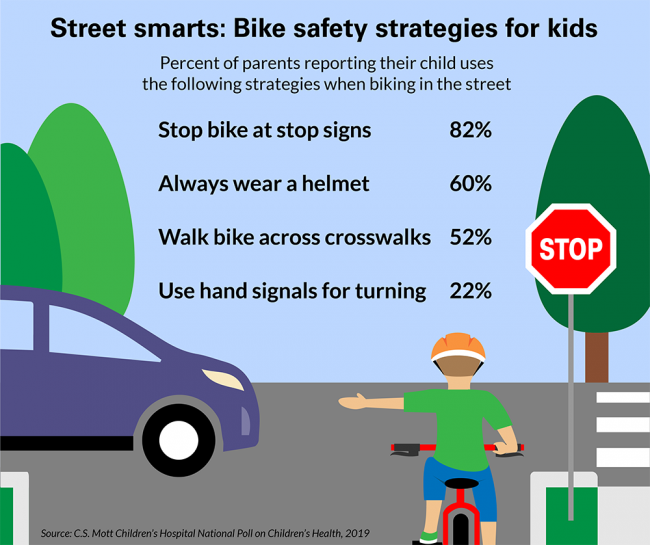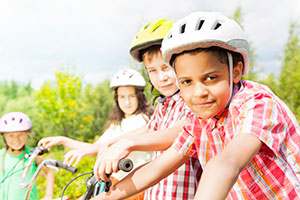Safety on wheels: Teaching kids to ride right


Safety on wheels: Teaching kids to ride right
Children ride a variety of non-motorized vehicles including bicycles, skateboards and scooters. Keeping kids safe while riding is important for parents but can be challenging. The C.S. Mott Children’s Hospital National Poll on Children’s Health asked a national sample of parents about their experiences and safety strategies for their children 4-13 years of age when riding non-motorized vehicles such as bicycles, scooters and skateboards.
Overall, 4 in 5 parents reported their child rides a bicycle, 50% ride non-motorized scooters, and 17% ride skateboards. Parents of kids who do not ride bikes cited lack of interest (51%), not knowing how to ride (40%) and having no safe place nearby to ride (22%) as the main reasons for not riding.
Among parents of children who ride bikes, most said their child rides on sidewalks (73%) and in parks or on trails (59%). More children ride on streets without bike lanes (42%) than streets with bike lanes (11%). Older children (age 11-13) are more likely to ride in the street (with or without bike lanes) compared with younger children (age 4-10).
Parents reported a wide range in the use of safety strategies by their children who ride bikes in the street. Most parents said their child gives cars the right of way (93%) and stops their bike at stop signs (82%), but only half said their child walks their bike at crosswalks (52%). The least commonly used safety strategy was the use of hand signals for turning, reported by only 22% of parents.
Wearing helmets is an important safety strategy to prevent head injuries in case a child falls or is struck by a car. However, only 59% of parents reported their child always wears a helmet when biking, while 18% said their child never wears a helmet. Parents who said their child always wears a helmet was even lower for skateboarding (42%) and riding a scooter (39%). Parents were more likely to say that younger children always wear a helmet compared to older children.
Although most parents reported having a rule that their child always wear a helmet, some said they did not have a helmet rule for bike riding (22%), skateboarding (27%) or riding a scooter (34%).

Highlights
- 1 in 5 parents report their child never wears a helmet when riding a bike.
- Most parents acknowledge their child does not use hand signals or walk their bike across crosswalks.
- Some parents report not having helmet rules for bikes (22%), skateboards (27%), and non-motorized scooters (34%).
Implications
Whether children are riding bicycles, skateboards, or non-motorized scooters, proper precautions need to be taken to ensure they are safe, including wearing helmets and understanding safety in the streets. This Mott Poll suggests that parents need to be more vigilant about ensuring their children use basic safety strategies on wheels.
A key safety decision that parents must make is where their child should ride. Parents in this Mott Poll reported that younger children usually ride their bike on the sidewalk. When local laws allow this, riding on the sidewalk is a good safety strategy, as it keeps younger children out of the way of cars. At younger ages, parents should accompany children and teach them essential safety lessons, such as slowing down, using a bell, and alerting pedestrians that they are approaching. In addition, children biking on the sidewalk should stop at intersections and walk their bike across the crosswalk, as passing cars may not be looking for a bike to emerge from the sidewalk.
As children get older and ride more often, they will gain the experience and confidence to ride in the street. Parents need to teach their children that when they ride on the road, they are expected to obey all traffic laws like any other vehicle on wheels. This includes riding in the same direction as the flow of traffic, making a complete stop at stop signs, and obeying the lights in traffic signals. Other important safety practices include using hand signals when turning so drivers know what to expect. Unfortunately, a substantial number of parents in this Mott Poll reported that their children do not follow these basic safety strategies.
Some parents may prefer their children to ride in streets that have a designated bike lane; however, bike lanes are not guarantees that children will not encounter safety hazards. It is important that children stay alert for cars that are turning or cars that are driving too close to the bike lane. If riding feels unsafe, children should move onto the sidewalk or the side of the road, get off their bike, and walk until they get to a safe place to ride. Children also need to be on the lookout for people getting in or out of parked cars. Many children are injured each year when a driver opens their car door onto the street and strikes an oncoming bicycle. Children riding in the street need to watch out when they see a car parking or a driver about to enter their car to prevent being “doored.”
It is recommended that skateboards and scooters not be ridden in the street. When riding on the sidewalk, the same rules apply as with biking: slowing down for pedestrians, stopping at intersections, and walking across the crosswalk. Many communities have skate parks and bike/scooter paths that offer a place for children to ride where they are safe from cars and away from pedestrians.
Among the most important safety strategies proven to reduce injuries is wearing a helmet, no matter what type of non-motorized vehicle a child might be riding. This Mott Poll found that many parents are not requiring their child to wear a helmet: 1 in 5 parents of bikers, 1 in 4 parents of scooter riders, and 1 in 3 parents of skateboarders said their child never wears a helmet. This is concerning. Moreover, just wearing a helmet is not enough. To get the most protection, helmets need to be used correctly. Helmets should fit snugly on the head, and be positioned to cover the forehead and not be tipped backward or forward. The buckle on the chin strap should be centered under the chin and tightened the until it is snug; no more than one to two fingers should be able to fit between the chin and strap. When fitted, the helmet should not rock more than one inch side to side or front to back.
Attention to safety is important because, on average, there are over 600 children each day who end up in the emergency department with a bicycle-related injury. Children 10-14 years are the most likely to be injured, and boys more commonly than girls.
Bikes, skateboards, and non-motorized scooters can be a fun way to get from place to place, get some exercise, and improve balance skills. A few common-sense safety precautions can make sure it is both fun and safe.

Data Source & Methods
This report presents findings from a nationally representative household survey conducted exclusively by Ipsos Public Affairs, LLC (Ipsos), for C.S. Mott Children’s Hospital. The survey was administered in February 2019 to a randomly selected, stratified group of parents age 18 and older (n=2,032). Adults were selected from Ipsos’s web-enabled KnowledgePanel® that closely resembles the U.S. population. The sample was subsequently weighted to reflect population figures from the Census Bureau. The survey completion rate was 60% among panel members contacted to participate. This report is based on responses from 1,330 parents who had at least one child 4-13 years. The margin of error is ±2 to 7 percentage points.
Findings from the C.S. Mott Children’s Hospital National Poll on Children’s Health do not represent the opinions of the University of Michigan. The University of Michigan reserves all rights over this material.
Citation
Freed GL, Singer DC, Gebremariam A, Schultz SL, Clark SJ. Safety on wheels: Teaching kids to ride right. C.S. Mott Children's Hospital National Poll on Children's Health, University of Michigan. Vol 34, Issue 2, May 2019. Available at: https://mottpoll.org/reports/safety-wheels-teaching-kids-ride-right.

